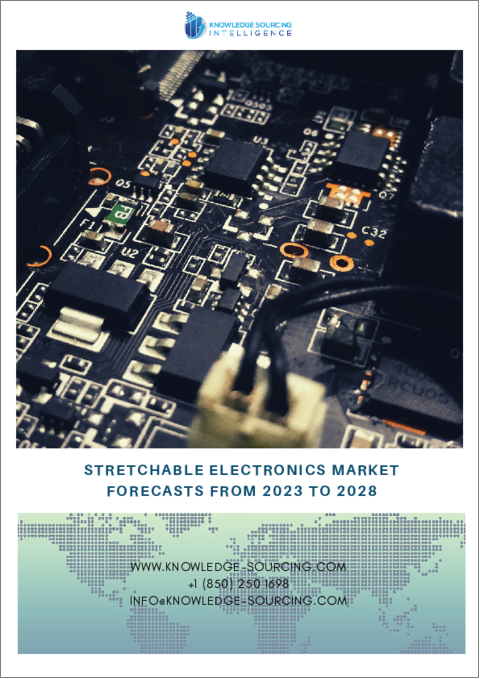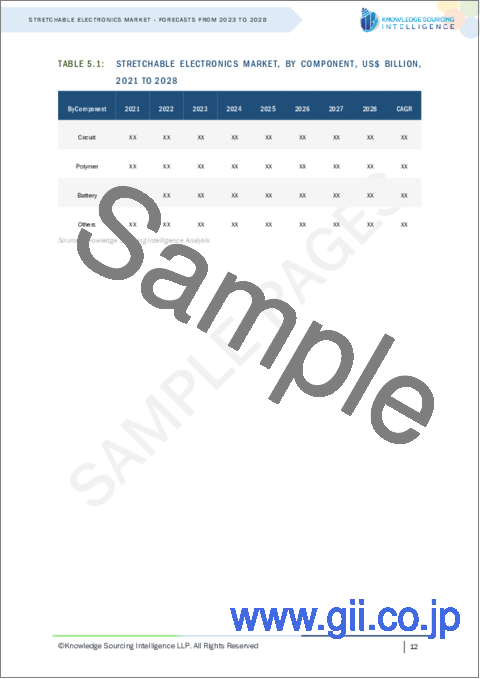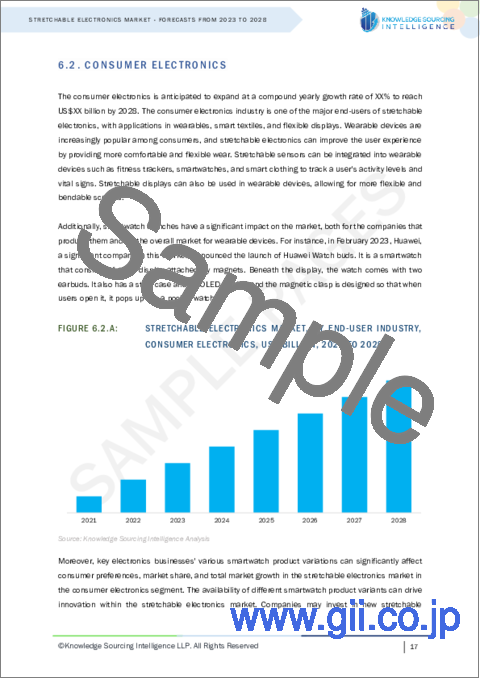|
|
市場調査レポート
商品コード
1122465
伸縮性エレクトロニクスの世界市場:2022年~2027年Stretchable Electronics Market - Forecasts from 2022 to 2027 |
||||||
|
● お客様のご希望に応じて、既存データの加工や未掲載情報(例:国別セグメント)の追加などの対応が可能です。 詳細はお問い合わせください。 |
|||||||
| 伸縮性エレクトロニクスの世界市場:2022年~2027年 |
|
出版日: 2022年07月13日
発行: Knowledge Sourcing Intelligence
ページ情報: 英文 136 Pages
納期: 即日から翌営業日
|
- 全表示
- 概要
- 目次
伸縮性エレクトロニクスの市場規模は、2020年の80億2300万米ドルから、予測期間中は31.85%のCAGRで推移し、2027年には555億8,800万米ドルの規模に成長すると予測されています。
革新的な技術の進歩とポータブル電子製品への需要の高まりが市場の成長を増大させると予想されています。
当レポートでは、世界の伸縮性エレクトロニクスの市場を調査し、市場の定義と概要、市場成長への各種影響因子の分析、市場規模の推移・予測、各種区分・地域/主要国別の内訳、競合環境、主要企業のプロファイルなどをまとめています。
目次
第1章 イントロダクション
第2章 調査手法
第3章 エグゼクティブサマリー
第4章 市場力学
- 市場促進要因
- 市場抑制要因
- ポーターのファイブフォース分析
- 産業バリューチェーン分析
第5章 伸縮性エレクトロニクス市場:コンポーネント別
- 回路
- ポリマー
- 電池
- その他
第6章 伸縮性エレクトロニクス市場:エンドユーザー産業別
- CE製品
- ヘルスケア
- 航空宇宙・防衛
- 通信・技術
- 自動車
- その他
第7章 伸縮性エレクトロニクス市場:地域別
- 北米
- 南米
- 欧州
- 中東・アフリカ
- アジア太平洋
第8章 競合環境・分析
- 主要企業および戦略の分析
- 新興企業と市場の収益性
- M&A・契約・提携
- ベンダーの競合マトリックス
第9章 企業プロファイル
- DuPont
- Adidas AG
- 3M
- PARC
- Cambrios
- MC10
- AU Optronics
- Enfucell Flexible Electronics Co. Ltd.
- Samsung
- Bluespark Technologies
The stretchable electronics market is projected to grow at a CAGR of 31.85% during the forecast period to reach US$55.588 billion by 2027, from US$8.023 billion in 2020. Stretchable electronics, also termed elastic circuits, are architected by embedding electronic circuits and components on a stretchable substrate, like polyurethanes and silicones, to build a completed circuit design. These elastic electronics possess the ability to endure large strains without affecting the functionality of the device. These electronics are designed to bio mimic the human skin by being stretchable while retaining complete functionality. Soft and conformable electronics are rapidly emerging as the future of next-generation electronic devices, owing to their easy deployment in a variety of environments, such as on-skin, on-body, or biomedical implants. Furthermore, the development of nanofabrication, nanomaterials, and additive manufacturing is further augmenting the stretchable electronics market. The market for stretchable electronics is segmented based on the type of components, end-user industries, and geographical regions.
The advancements in innovative technologies and the growing demand for portable electronic products are expected to augment the market's growth.
Stretchable electronics are gaining heightened attention among the academic community and competitive landscape for their immense potential and versatility. Owing to their appealing features such as portability, flexibility, and light and thin attributes, they could be deployed in an array of innovative segments, including biomedical engineering, automotive, soft robotics, epidermal electronic devices, and many more. Advancements in 3D printing technology and nanotechnology have further unlocked the possibilities of these devices. The development of a glucose-monitoring contact lens is the best example of this. A study funded by the Samsung Science and Technology Foundation, the Ministry of Science, and ICT in Korea has further proved the feasibility of such a lens in the diagnosis of diabetes. Furthermore, in June 2021, the researchers at Stanford innovated a technique to build an ultrathin and flexible electronic circuit of fewer than 100 nanometres in length. Researchers believe that 'Flextronics' has become close to reality with this new development. Such developments are further augmented by the initiatives taken by the various governments. For instance, in February 2021, Indian National Centre for Flexible Electronics and MeitY launched the 'FlexE Innovation Challenge' in response to changing technologies and growing demand for reliable technological solutions. Further, in July 2021, the Department of Defense of the United Nations showed a growing interest in flexible electronic designs and had invested in NextFlex, an electronic innovator. The investment also included a $154 million prize for an Army-led flexible electronics project. Similar ongoing developments are expected to add impetus to the market growth. Nevertheless, developing a suitable stretchable substrate and the costs and time associated with it are expected to restrain the market's growth.
The fierce competitive landscape and strategic developments deployed by the key players in the North America and Asia Pacific regions are expected to drive the market exponentially.
By geography, the stretchable electronics market is segmented into Asia Pacific, North America, South America, Europe, the Middle East and Africa. North America and the Asia Pacific are expected to hold a dominant market share globally. The growth in these regions is attributed to the increasing technological innovations and strategic developments, such as launches, investments, and partnerships, by the enterprises in the region to increase their brand presence. Pragmatic Semiconductors are the best example of this. In April 2022, a venture capital firm, Cambridge Innovation Capital, predominantly active in life science and technology industries, raised £225 million in funds for its oversubscribed funding round II. CIC's portfolio company, Pragmatic Semiconductor, one of the portfolio companies of CIC and a low-cost, flexible integrated circuits provider, had raised about $80M to build another facility in the northern part of England. Further in 2022, Amcor announced a strategic investment in Pragmatic Semiconductors in the former's pursuit to discover and innovate technologies for packaging technologies. In 2020, Henkel Adhesive Technologies and Quad Industries had teamed up and launched a smart health patch for COVID-19 patients. In March 2021, the two companies further expanded their collaboration to develop printed electronic solutions. Another such example is Boron Molecular's partnership with CSIRO and KISCO. In July 2020, Australia's National Science Agency, CSIRO, and South Korea-based Kyung-In Synthetic Corporation took a minority shareholding in Melbourne-based Boron Molecular. With CISRO Technologies' aid, this partnership was expected to enable the development of the latter's manufacturing capacity in Australia and increase its presence in the global market.
COVID-19 Insights
COVID-19 has slowed down the stretchable electronics market. The mandated social distancing measures and lockdowns implemented by various governments have led to several production facilities' complete or partial closure. Coupled with social distancing measures and an increase in active cases, industry staffing is declining, slowing productivity. Furthermore, the travel restrictions imposed by several borders further led to gaps in supply and demand chains. However, stretchable electronics in the healthcare industry saw significant developments with an increase in immediate demand for health solutions. Henkel's collaboration with several other companies to design and launch a smart health patch for COVID-19 in 2020 is one of the best examples of this.
Market Segmentation:
- By Component
Circuit
Polymer
Battery
Others
- By End-user Industry
Consumer Electronics
Healthcare
Aerospace and Defense
Communication and Technology
Automotive
Others
- By Geography
North America
- United States
- Canada
- Mexico
South America
- Brazil
- Argentina
- Others
Europe
- Germany
- UK
- France
- Spain
- Italy
- Others
Middle East and Africa
- Saudi Arabia
- Israel
- Others
Asia Pacific
- China
- Japan
- India
- Indonesia
- South Korea
- Taiwan
- Others
TABLE OF CONTENTS
1. INTRODUCTION
- 1.1. Market Overview
- 1.2. COVID-19 Scenario
- 1.3. Market Definition
- 1.4. Market Segmentation
- 1.5. Scope of the Study
- 1.6. Currency
- 1.7. Assumptions
- 1.8. Base, and Forecast Years Timeline
2. RESEARCH METHODOLOGY
- 2.1. Research Design
- 2.2. Secondary Sources
3. EXECUTIVE SUMMARY
- 3.1. Research Highlights
4. MARKET DYNAMICS
- 4.1. Market Drivers
- 4.2. Market Restraints
- 4.3. Porter's Five Forces Analysis
- 4.3.1. Bargaining Power of Suppliers
- 4.3.2. Bargaining Powers of Buyers
- 4.3.3. Threat of Substitutes
- 4.3.4. Threat of New Entrants
- 4.3.5. Competitive Rivalry in the Industry
- 4.4. Industry Value Chain Analysis
5. STRETCHABLE ELECTRONICS MARKET BY COMPONENT
- 5.1. Introduction
- 5.2. Circuit
- 5.3. Polymer
- 5.4. Battery
- 5.5. Others
6. STRETCHABLE ELECTRONICS MARKET BY END-USER INDUSTRY
- 6.1. Introduction
- 6.2. Consumer Electronics
- 6.3. Healthcare
- 6.4. Aerospace and Defense
- 6.5. Communication and Technology
- 6.6. Automotive
- 6.7. Others
7. STRETCHABLE ELECTRONICS MARKET BY GEOGRAPHY
- 7.1. Introduction
- 7.2. North America
- 7.2.1. United States
- 7.2.2. Canada
- 7.2.3. Mexico
- 7.3. South America
- 7.3.1. Brazil
- 7.3.2. Argentina
- 7.3.3. Others
- 7.4. Europe
- 7.4.1. Germany
- 7.4.2. UK
- 7.4.3. France
- 7.4.4. Spain
- 7.4.5. Italy
- 7.4.6. Others
- 7.5. Middle East and Africa
- 7.5.1. Saudi Arabia
- 7.5.2. Israel
- 7.5.3. Others
- 7.6. Asia Pacific
- 7.6.1. China
- 7.6.2. Japan
- 7.6.3. India
- 7.6.4. Indonesia
- 7.6.5. South Korea
- 7.6.6. Taiwan
- 7.6.7. Others
8. COMPETITIVE ENVIRONMENT AND ANALYSIS
- 8.1. Major Players and Strategy Analysis
- 8.2. Emerging Players and Market Lucrativeness
- 8.3. Mergers, Acquisitions, Agreements, and Collaborations
- 8.4. Vendor Matrix and Analysis
9. COMPANY PROFILES
- 9.1. DuPont
- 9.2. Adidas AG
- 9.3. 3M
- 9.4. PARC
- 9.5. Cambrios
- 9.6. MC10
- 9.7. AU Optronics
- 9.8. Enfucell Flexible Electronics Co. Ltd.
- 9.9. Samsung
- 9.10. Bluespark Technologies




